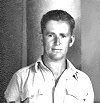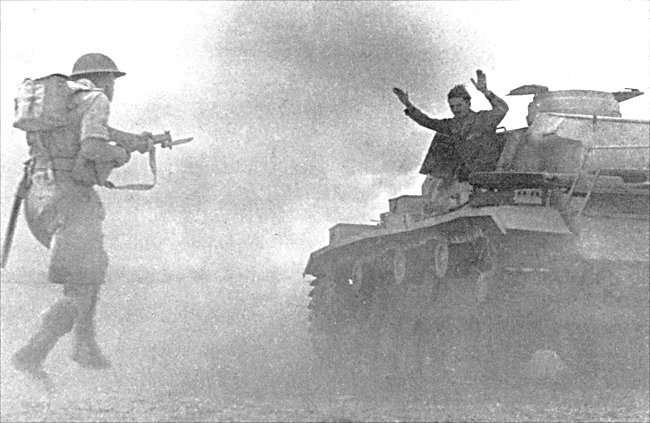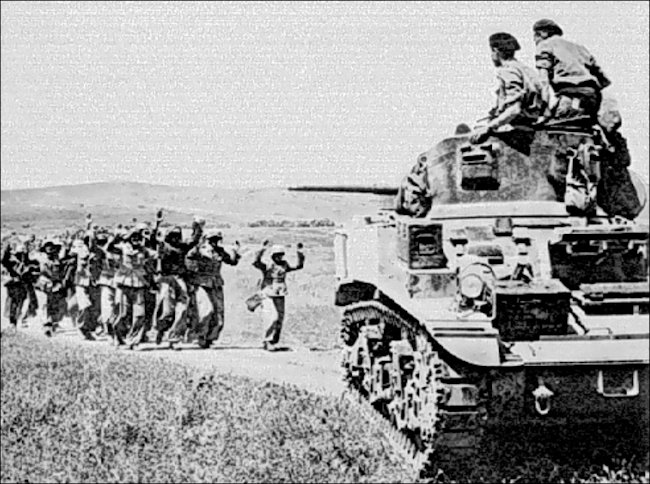2nd Battalion Kings Royal Rifle Corps April Advance Tunisia 1943
Len Moore fought with the 2nd Battalion Kings Royal Rifle Corps 2/KRRC across the deserts of North Africa during WW2 from 1941 to 1943. This page covers his units April advance in Tunisia 1943.

Len Moore 2nd Battalion Kings Royal Rifle Corps
Tunisian Front April 1943
April found us again in contact, and again in really hilly country. Relieving a motor battalion of the Rifle Brigade in the First Army, we were soon involved in the favourite roles of active patrolling by night and We operated round the village of Djebebina. l do not think anyone in the Battalion will ever forget that name.
It was our pivot of manoeuvre for the next month; try as we could, we Were never able to get away from it. Here the country was not unlike Mareth but the hills were higher, and above us always towered the dominating peak of Zaghouan, 8,000 ft. high.

A Tommy holding a Nazi Flag posing for the camera with three German POWs
On both sides our neighbours were French, and many were the interesting, but somewhat one-sided conversations we had with General Leclerc. Luckily we had a first-class interpreter in Luke Asquith, the Intelligence Officer. The enemy were now on their final stand; there seemed little evidence of evacuation, and we resigned ourselves to finding out all possible information prior to the inevitable full-scale attack in the future which soon appeared unpleasantly obvious.
The Battalion suffered casualties daily : we seemed to have an unending spell of bad weather. Bob Cox, our last remaining American officer, was wounded on a daylight reconnaissance and died of his wounds: a great loss to us all.
They had been ill-fated, it seemed, from the start in both the battalions. Major Curtis lost his Second-in-Command, Captain Cantlon, and a platoon commander, Lieutenant Jackson, was wounded by one stray 75-mm shell fired at random at 2300 hrs just as the company were forming up for a local attack, and there were many excellent N.C.Os. and men lost on day and night patrols.
On one of these Corporal J. Minns put up a wonderful show, bringing back valuable information and four wounded men, being himself hit in two places. He received the D.C.M. later. So April dragged on. Everyone was getting rather battle weary, struggling to gain moral superiority over a determined and strongly entrenched enemy.
It was with great relief we learned of the big switch round of 4th Indian Division and 7th Armoured Division to force the First Army, We were to continue to exert maximum pressure in the Eighth Army, but the main blow was to go in through the Goubellat Plain farther north on 13th April 1943.
This afforded us some respite, but we remained in the line and, in junction with the French and the gunners supporting us, continued to make life as uncomfortable as possible for the Hun opposite. No more Italians were left. Lieutenant Jackson did an excellent patrol one night, his first outing after dark and brought in a couple of German prisoners, one a warrant officer, without firing a shot.
These gave us valuable identifications but little information, so often the case with Germans. After our long spell of ill-luck we really made the most of this success, which was just what was wanted to encourage everybody. Our two forward companies lived below ground all day, being only 800 yards from the enemy first defence lines; consequently Major Lowe's and Major Curtis's companies bore the brunt of the patrolling and incidentally got most of the shelling.
It was therefore arranged that two platoons of B Company, Nos. 6 and 7, would be sent up to join C Company, and A Company would occupy the other feature. At last light, what appeared to be an artillery preparation by 75 mms. came down on our positions, under which more enemy commenced creeping up the eastern slopes of 308. Our defensive fire, though falling some 300yds. short to start with, and uncomfortably close to our own troops, was effective.

German Panzer Mark III tank crew surrender to a British Tommy in the North African Desert
The final Surrender of the Axis forces in Africa May 1943
On 2nd May the big attack by the combined First and Eighth went farther north: as the world knows, they were blessed with success and by 6th May Tunis had fallen. When this news reached the ears of Germans opposite us we did not discover until later, but it was not a further forty-eight hours had elapsed that the 29th Panzer Grenadiers decided to surrender.
On the afternoon of 13th May they fired every round remaining into our area. 105, 75, 50 mm., anti-tank, machine-gun and bullets came over in hundreds from 1430 hrs. to 1500 hrs. thirty-two anti. tank shells (A.P.) landed in the Brigade area alone. Our gunners replied with "twenty rounds gunfire," but all to no avail.
The Germans had orders and they were going to carry them out. The poor 2nd Battalion had a most uncomfortable half-hour, but by what seemed a miracle suffered only one casualty. We just sat in slit trenches and waited, knowing this was the end. The Colonel returned from his course in time to hear the last round fired in Africa about 1700 hrs. that night fired by the French "Big Bertha" a few kilometres in our rear.

British Stuart Honey tank crew take surrender of German Africa Korps infantry